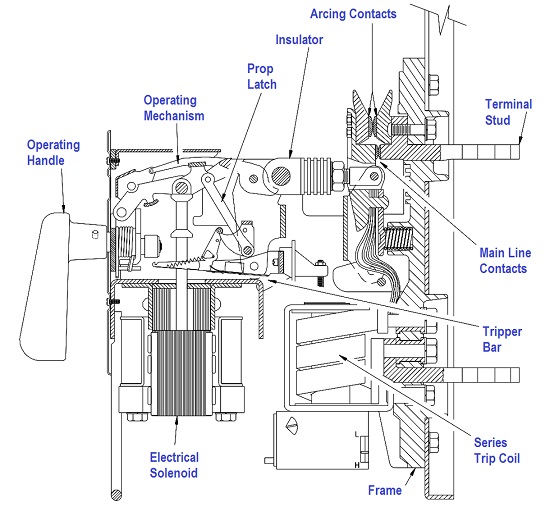The next article in our series on Circuit Breakers discusses a few common types of breakers.
Missed out on the first two articles? Follow the links below to catch up on parts one and two in the series:
Part Two
- Learn about what circuit breakers typically comprise of.
In the third article of the series, we give you an overview of miniature, molded case, residual current and air circuit breakers….
Types of Circuit Breakers
1. Miniature Circuit Breakers
A Miniature Circuit Breaker (MCB) serves the purpose of both switching and preventing damage to an electrical circuit when excess current flows. It is an electromechanical device that protects the electrical wires and load from overcurrent to prevent damage or fire. MCB’s are used in domestic applications because of the overload and short circuit protection they offer, as well as the ease with which they can be reset.
2. Molded Case Circuit Breakers
A Molded Case Circuit Breaker (MCCB) is used when the load current exceeds the limit of a miniature circuit breaker. MCCBs are used in industrial applications because of their wide current ratings and higher breaking capacity. They offer adequate protection when an application requires discrimination, adjustable overload settings or earth fault protection.
The Table below highlights a few differences between MCBs and MCCBs:
| MCB | MCCB |
|---|---|
| Maximum rated current of 125A | Maximum rated current of 1600A |
| Maximum interrupted current rating is less than 10kA | Maximum interrupted current rating is in the range of 10 – 85 kA |
| Used in applications that require a low breaking capacity | Used in applications that require either low or high breaking capacity |
| Trip characteristics are not adjustable | Trip characteristics can be fixed or adjustable depending on the application |
| Provides protection for electrical wiring and equipment | Provides protection for electrical wiring and equipment |
3. Residual Current Circuit Breakers
A Residual Current Circuit Breaker (RCCB) is a device that disconnects the electrical circuit in the event of leakage current flowing through a living being, or when the current is not balanced between the phase and neutral conductor. It detects and trips the circuit in the event of leakage current, preventing shock caused by direct contact. The device is used in series with an MCB and is a necessity for shock protection.
4. Air Circuit Breakers
An Air Circuit Breaker (ACB) is electronic equipment that is used for the protection of electric circuits from short circuits or overcurrent. ACBs are used in the switching mechanism and protection of the electrical system. Standard ACB ratings typically range from 400A to 1600A. Some of the higher class ACBs typically have a maximum current rating of 5000A.
Functions:
- It opens or closes a circuit automatically or manually.
- Opens circuits automatically when a fault takes place such as over current, short circuit, earth fault, over frequency, reverse power, etc.
- It dampens the arcing in case of overloading
Types:
- Plain Break type ACB
- Magnetic Blowout Type ACB
- Air Chute ACB
- Air Blast Circuit Breaker
Learn more about Circuit breaker technology
What to learn more?
Take an in depth look at circuit breakers with a special emphasis on the Eaton's most technologically advanced circuit breaker, the Power Defence molded case circuit breaker...
Click HERE to watch the video now!


